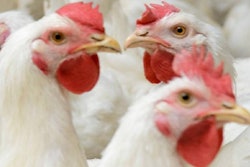The production of reactive oxygen species (ROS) is a normal physiological process, but when they exceed an animal’s antioxidant defenses, oxidative stress occurs which can lead to loss of performance, and health and reproduction issues. On July 20, during the 2017 Poultry Science Association annual meeting, five speakers addressed the issue from different viewpoints as part of the Oxidative Stress Symposium, sponsored by Adisseo.
As part of the event, Walter Bottje, University of Arkansas, Peter Surai, Feed-Food Ltd, Charlotte Lauridsen, Aarhus University, Xingen Lei, Cornell University, and Michael Lilburn, Ohio State University, presented their recent research and contributed to the audience Q&A session.
“We’re proud to sponsor this PSA session on oxidative stress to bring together diverse experience from different areas of study and different parts of the world,” said Pierre-Andre Geraert, Director Innovation Marketing, Adisseo France. “To improve animal protein production efficiency, we need to help animals better manage oxidative stress, which is the basis of the aerobic metabolism.”
Prof Walter Bottje, a physiologist in the Department of Poultry Science at the University of Arkansas, has focused his research on antioxidants and oxidative stress. During his talk, Efficiency and oxidative metabolism: The difficult balance, Bottje expanded on the direct relationship they found between mitochondrial function and feed efficiency. The symposium kicked off with Bottje’s talk due to the role of mitochondria as the main producer of ROS. He explained the underlying mechanisms of ROS and their negative impact, and discussed potential ways to alleviate electron leak, a major cause of ROS.
Prof Peter Surai, who has been working with antioxidants for almost 40 years, explained how by nutritional means we can affect antioxidant defenses, and how antioxidants interact with each other in the body to build antioxidant systems. In his talk, Nutritional modulation of the antioxidant capacities in poultry, Surai focused on selenium, on the 200th anniversary of its discovery. He commented that “From all antioxidants we know today, selenium has a special place as the element that regulates a lot of physiological functions in the body.” Surai noted that more than 20 years of research has shown organic selenium, specifically selenomethionine, as the most effective form of selenium.
Dr. Charlotte Lauridsen, who works in nutritional immunology at Aarhus University in Denmark, presented From oxidative stress to Inflammation: Redox balance and immune system. She presented research results on using antioxidant therapy during critical periods to control oxidative stress reactions in order to enhance immunity and robustness in pigs and poultry. “Oxidative stress and inflammation are natural reactions,” said Lauridsen. “However, if they are out of control we will have severe problems with feed digestion and enteric health.”
Xingen Lei, Professor of Molecular Nutrition at Cornell University, presented Avian selenogenome: Response to dietary Se and protection against oxidative insults, where he introduced the general biology of the selenogenome in chicks and explained how it’s regulated by different forms and dietary concentrations of selenium. “I have studied selenium for over 35 years in different species, looking at different functions of selenium-dependent proteins and their relationship with different types of metabolism including energy and protein metabolism, and chronic diseases.” For his work, Lei recently received two awards: the 2017 FASS-AFIA New Frontiers in Animal Nutrition Award as well as the Gary L. Cromwell Award for Research in Minerals from the American Society of Animal Science.
Prof Mike Lilburn, from the Department of Animal Science Ohio State University, concluded the symposium with his presentation Meat: From muscle to food—Oxidative challenges and developmental anomalies. Lilburn focused on the role of oxidative stress as muscle makes the transition from live product to meat, focusing on understanding the onset of breast muscle myopathies in heavy broiler chickens, commonly referred to as woody breast. As part of his studies on the molecular mechanisms underlying the onset of woody breast, Lilburn stated he is “Proposing a model for woody breast pathology based on compartment syndrome, which is where the muscle outgrows the ability of fascia to expand accordingly.”
Roger Sunde, Professor of Nutritional Sciences, University of Wisconsin and co-chair of the event, said, “It’s clear from the nature of selenoenzymes that they’re important and have roles in protecting against oxidative stress and ROS. The genetics of poultry have changed in last 20 years, and so investigating the role of selenium and protecting against ox stress in these new birds and with new diets makes a lot of sense.”

















